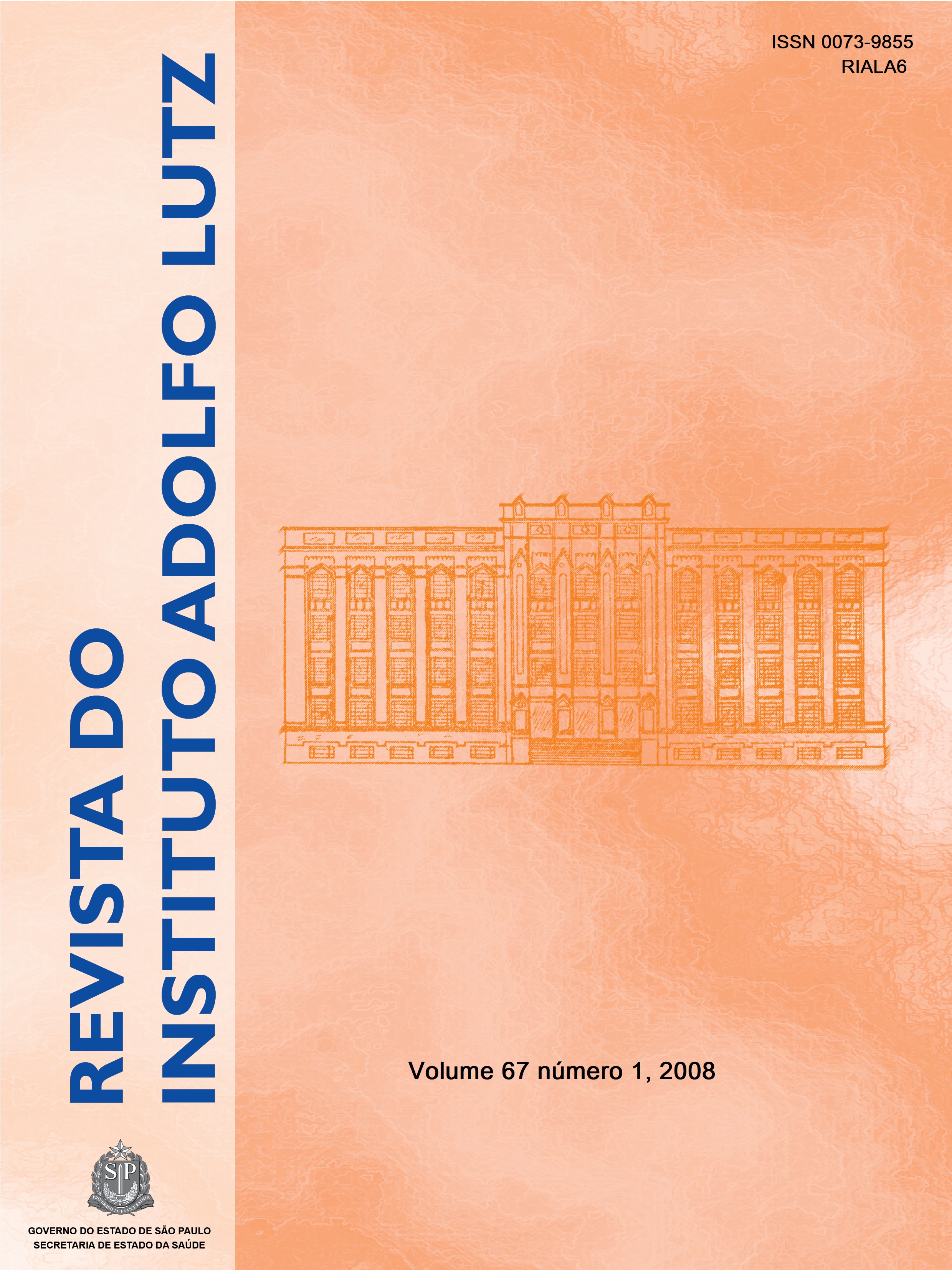Resumo
A obesidade tem se tornando significante problema de saúde pública no Brasil. Atualmente, os produtos denominados “fórmulas emagrecedoras” são encontrados em profusão no mercado, com o argumento de promover redução de peso corpóreo. No período de junho de 2004 a março de 2007, foram efetuadas na Seção de Farmacognosia do Instituto Adolfo Lutz Central/ SP análises de 22 amostras de fórmulas para pesquisar a presença de anorexígenos (dietilpropiona, femproporex, mazindol) e benzodiazepínicos (clordiazepóxido, clonazepam, diazepam, bromazepam, lorazepam). Foi empregada a cromatografia em camada delgada comparativa frente aos respectivos padrões; a avaliação de conformidade da rotulagem foi realizada seguindo-se a legislação vigente. Os limites de detecção foram determinados para cada fármaco pesquisado, com os padrões utilizados na respectiva técnica de cromatografia. Três amostras apresentaram dietilpropiona ou diazepam com femproporex, as quais não estavam declaradas nos seus rótulos e nos rótulos de todas as amostras analisadas houve a menção da presença de substâncias laxantes. Das amostras analisadas, 16 estavam em desacordo com a legislação específica vigente quanto aos dizeres de rótulo. A associação de anorexígenos com benzodiazepínicos e laxantes, embora proibida pela legislação brasileira, é ainda encontrada nos produtos comercializados, constituindo-se importante risco à saúde dos usuários. Este fato merece assim, atenção especial e constante dos órgãos de fiscalização.Referências
1. Obesity. Acesso em: 25 abr 2007. Disponível em <http://www.who.int/topics/obesity/em/>.
2. IBGE. Pesquisa de orçamentos familiares - POF2002-2003. Excesso de peso atinge 38,8 milhões de brasileiros adultos. Comunicação Social de 16 de dezembro de 2004. Acesso em 04 abr 2007. Disponível em: <http://www.ibge.gov.br/home/presidencia/noticias/noticia_visualiza.php?id_noticia=278>.
3. Pereira LO, Franchini RP, Lancha Jr, AH Obesidade: hábitos nutricionais, sedentarismo e resistência à insulina. Arq Bras Endocrinol Metab 2003, 47(2), 111-27.
4. Azevedo FS, Guimarães RI, Paula JR, Cunha LC. Validação de técnica analítica em cromatografia em camada delgada comparativa para identificação de fármacos anorexígeno ssintéticos em produtos fitoterápicos. Infarma 2005, 17 (5/6),86-8.
5. Brasil. Portaria n° 344, de 12 de maio de 1998 da Secretaria daVigilância Sanitária do Ministério da Saúde. Regulamento Técnico sobre substâncias e medicamentos sujeitos acontrole especial. Acesso em 03/04/2007. Disponível em:http://e-legis.anvisa.gov.br/leisref/public/showAct.php?id=17235&word=3.
6. Rang HP, Dale MM, Ritter JM, Moore PK. Fármacos ansiolíticos e hipinóticos In: Farmacologia, 5 edição. Rio deJaneiro: Elsevier; 2004. p. 589-595.
7. Hoffman BB, Lefkowitz RJ. Catecholamines, Sympathomimetic Drugs, and Adrenergic Receptor Antagonists. In: Hardman JG, Limbird LE. Goodman &Gilman’s The Pharmacological Basis of Therapeutics, 9ªedição. New York: McGraw Hill,1996. p.224.
8. Hobbs WR, Rall TW, Verdoorn TA. Hypnotics and Sedatives; Ethanol. In: Catecholamines, Sympathomimetic Drugs, and Adrenergic Receptor Antagonists. In: Hardman JG, Limbird LE. Goodman & Gilman’s The Pharmacological Basis of Therapeutics, 9ª edição. New York: McGraw Hill,1996. p. 362-386.
9. MERCOSUL/GMC/RES. N.º 39/99 Regulamento Técnico Sobre Associações de Drogas em Medicamentos e Preparações Magistrais que contenham Anorexígenos Acesso em 04 abr. de 2007. Disponível: <http://www.anvisa.gov.br/legis/resol/mercosul/39_99.htm>.
10. Brasil. Resolução n° 1477, de 11 de julho de 1997 do Conselho Federal de Medicina. Dispõe sobre o uso de substâncias tipo anfetaminas, isoladamente ou em associação combenzodiazepínicos, diuréticos, hormônios e laxantes, com finalidade exclusiva de tratamento de obesidade ou emagrecimento. Acesso em 04 abr 2007. Disponível em: http://e-legis.bvs.br/leisref/public/showAct.php?id=6320.
11. Brasil. Resolução CFF n° 273, 30 de agosto de 1995 do Conselho Federal de Farmácia. Dispõe sobre manipulação medicamentosa. Acesso em 04 abr 2007. Disponível em http:// e-legis. bvs.br/ leisref/ public/showAct.php?id=6320.
12. Auricchio MT, Bactistic MA, Markman BEO. Detecção deanorexígenos e benzodiazepínicos em formulações “naturais”empregadas em regime de emagrecimento. Rev Inst AdolfoLutz 1990; 51(1/2): 105-10.
13. Moffat AC, Editor. Clarke’s isolation and identification of drugs. 2nd ed. London: The Pharmaceutical Press; 1986, 1223 p.
14. Ribani M, Bottoli CBG, Collins CH, Jardim ICSF, Melo LFC. Validação em métodos cromatográficos e eletroforéticos. Quim Nova 2004; 27(5): 771-80.
15. Brasil. Resolução RDC n° 33, de 19 de abril de 2000 da Agência Nacional de Vigilância Sanitária. Regulamento Técnico sobre Boas Práticas de Manipulação de Medicamentos emfarmácias. Acesso em 04 abr 2007. Disponível em http:// e-legis. bvs.br/ leisref/ public/ showAct.php?id=16678&Word=.
16. Brasil. Resolução RDC n° 333, de 19 de abril de 2003 da Agência Nacional de Vigilância Sanitária. Dispõe sobrerotulagem de medicamentos e outras providências. Acessoem: 04 abr 2007. Disponível em http:// e-legis. bvs.br/ leisref/public/ showAct.php? id=15220&Word=.
17. Brasil. Lei n° 8.078, de 11 de setembro de 1990 da Presidênciada República: Subchefia para Assuntos Jurídicos. Código de Defesa do Consumidor. Diário Oficial da República Federativa do Brasil, Brasília, v. 128, n° 176, supl., p. 1, 12 set.1990.
18. Anvisa suspende tiratricol. Acesso em: 04 abr 2007. Disponível em htpp://www.endocrino.org.br?noticia_c_exibe be.php?id=.

Este trabalho está licenciado sob uma licença Creative Commons Attribution 4.0 International License.
Copyright (c) 2008 Helena Miyoco Yano, Ana Paula Santos, Adriana Bugno, Mariângela Tirico Auricchio
